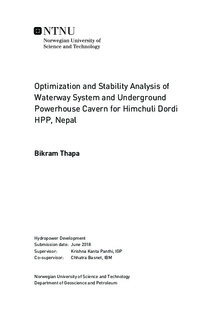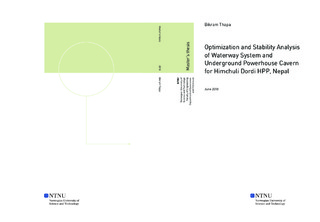| dc.description.abstract | Potential for hydropower development in Nepal is well established, and exploitation of the resource with economical and sustainable design is the need of the time. Unlined pressure tunnel is proven safe and economical waterway system in hydropower if it can be resided in good geological location. Project case for the thesis is Himchuli-Dordi HPP (56 MW) located in Higher Himalayan region of Nepal, near the regional thrust known as Main central thrust (MCT). Different alternatives for unlined waterway is devised considering the geological and accessibility perspective. Cavern orientation is also prepared for each alignment in connection with the jointing. Rock mass available in this zone are intensely sheared and mylontized. Weathering effect and tectonic forces are equally active in this region. Some of the common key issues like squeezing, leakage, tunnel collapse is identified from the completed projects from these regions. The purpose of this thesis is to analyze the unlined pressure tunnel waterway system and powerhouse cavern for the case project.
In this thesis, to understand the mechanism of unlined tunneling literature review on various methods is done. Norwegian Rule of thumb, Numerical methods are some of the used and discussed methods in this thesis. Another aspect of this thesis is to understand the unlined tunneling in context of Himalayan geology. Review of some of the completed projects which are similar to case project is discussed in order to narrow the analysis area. Using the Numerical model RS2, valley model of the critical locations identified from analytical and semi-analytical methods are developed. The same software is used to analyze the stability of the tunnel opening for different support systems. The support system of systematic bolting and Shotcrete lining devised as per the rock class type for the project case proves to be sufficient in most of the chainage sections considered. Some of the section located in geologically challenging places like; a valley, has higher hydrostatic pressure than the available minimum principal stress and, so could not stabilize with the established support system. Such zones are suggested to go for full concrete lining until the safe zone is reached. During optimization, it was found that the combination of an unlined tunnel in a relatively good geological formation and fully concrete-lined tunnel in the critical section can lower the overall cost of the system. However, the case will turn opposite if full concrete lining requirement is increased. The cheapest option then will be to limit fully concrete-lined tunnel as short as possible. Despite the limited geological information on the case, results can still be used as the indicator to the key issues that can be expected in such geological conditions. By increasing the database of information from precise and staged geological investigation will open the doors for an optimum solution in future | |

